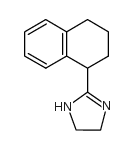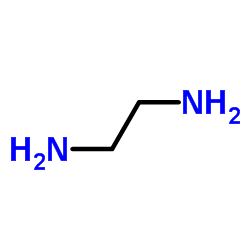Tetrahydrozoline
Modify Date: 2024-01-05 10:34:10

Tetrahydrozoline structure
|
Common Name | Tetrahydrozoline | ||
|---|---|---|---|---|
| CAS Number | 84-22-0 | Molecular Weight | 200.28000 | |
| Density | 1.2 g/cm3 | Boiling Point | 393.5ºC at 760 mmHg | |
| Molecular Formula | C13H16N2 | Melting Point | N/A | |
| MSDS | N/A | Flash Point | 191.8ºC | |
Use of TetrahydrozolineTetrahydrozoline is a potent α-adrenergic agonist and causes vasoconstriction. Tetrahydrozoline is used for the relief of conjunctival, ophthalmic and nasal congestion in vivo[1][2]. |
| Name | tetryzoline |
|---|---|
| Synonym | More Synonyms |
| Description | Tetrahydrozoline is a potent α-adrenergic agonist and causes vasoconstriction. Tetrahydrozoline is used for the relief of conjunctival, ophthalmic and nasal congestion in vivo[1][2]. |
|---|---|
| Related Catalog | |
| References |
| Density | 1.2 g/cm3 |
|---|---|
| Boiling Point | 393.5ºC at 760 mmHg |
| Molecular Formula | C13H16N2 |
| Molecular Weight | 200.28000 |
| Flash Point | 191.8ºC |
| Exact Mass | 200.13100 |
| PSA | 24.39000 |
| LogP | 1.87260 |
| Index of Refraction | 1.656 |
| Storage condition | -20℃ |
CHEMICAL IDENTIFICATION
HEALTH HAZARD DATAACUTE TOXICITY DATA
|
|
~% 
Tetrahydrozoline CAS#:84-22-0 |
| Literature: DE1009189 , ; US2731471 , ; |
|
~% 
Tetrahydrozoline CAS#:84-22-0 |
| Literature: DE1009189 , ; US2731471 , ; |
| Precursor 2 | |
|---|---|
| DownStream 0 | |
| 2-tetralin-1-yl-4,5-dihydro-1H-imidazole |
| EINECS 201-522-3 |
| Tetrahydrozolinum |
| tetrahydrozoline |
| Tyzanol |
| 2-(1,2,3,4-tetrahydronaphthalen-1-yl)-4,5-dihydro-1H-imidazole |
| Tetryzoline |
| Tetryzolin |


